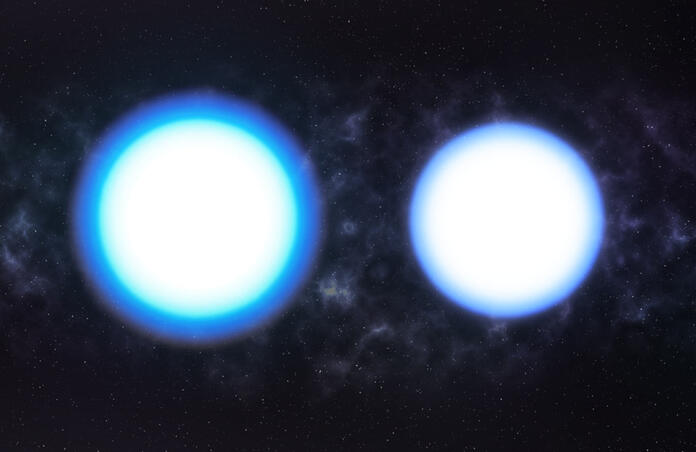Study finds that hotter white dwarfs are puffier

A team has investigated over 26,000 white dwarfs, confirming the predicted trend that hotter white dwarfs are slightly puffier than cooler ones, even at the same mass. Such results bring astrophysicists one step closer to using these stars to probe for the effects of extreme gravity and exotic dark matter particles.
White dwarfs are the cores of dead stars which have exhausted their hydrogen fuel in nuclear fusion. Such stars are extremely dense, being around 200,000x denser than earth. As a result, they have a large gravitational pull, hundreds of times stronger than earths.
"White dwarfs are one of the best characterized stars that we can work with to test these underlying theories of run-of-the-mill physics in hopes that maybe we can find something wacky pointing to new fundamental physics," said Nicole Crumpler, a Johns Hopkins University astrophysicist who led the work. "If you want to look for dark matter, quantum gravity, or other exotic things, you better understand normal physics. Otherwise, something that seems novel might be just a new manifestation of an effect that we already know."
The team at John Hopkins used measurements of how light emitted by white dwarfs were influenced by the extreme conditions. Light travelling away from massive objects loses energy due to escaping its gravity, causing wavelengths to shift to the red end of the spectrum. This effect reflects the warping of spacetime caused by extreme gravity, a prediction from Einstein’s theory of general relativity.
Observations from the Sloan Digital Sky Survey which uses telescopes in Chile and New Mexico were combined with European Space Agencys Gaia mission. Both of these surveys continuously map and track millions of stars, galaxies and other cosmic objects. The average motion of the white dwarfs relative to earth was calculated and grouped based on their gravity and size. From this, the team isolated gravitational redshift in order to measure how higher temperatures effect the volume of their gaseous outer layers. This study is the continuation of previous investigation by the same group, whereby 3000 white dwarfs were surveyed. This confirmed the theory that stars shrink as they gain mass due to electron degeneracy pressure – a process which keeps these cores stable over billions of years after which nuclear fusion has ceased.
Until now, the group didn’t have sufficient data to confidently confirm the more subtle but essential role temperature has on the mass-size relationship. "The next frontier could be detecting the extremely subtle differences in the chemical composition of the cores of white dwarfs of different masses," said Nadia Zakamska, a Johns Hopkins astrophysics professor who directed the research. "We don't fully understand the maximum mass a star can have to form a white dwarf, as opposed to a neutron star or a black hole. These increasingly high-precision measurements can help us test and refine theories about this and other poorly understood processes in massive star evolution."
These observations may also help astronomers look for signs of dark matter in the form of axions or other hypothetical particles. The team could use this data to uncover the signal of a specific model of dark matter that results in an interference pattern in the milky way. “If two white dwarfs are within the same dark matter interference patch then dark matter would change the structure of such stars in the same way”, said Crumpler.
Although dark matter has gravity, it doesn’t emit light or energy that can be seen by telescopes, so cannot be directly observed. However, due to this gravity, astronomers know that it makes up most of the matter in space. "We've banged our heads against the wall trying to figure out what dark matter is, but I'd say we have jack diddly squat," Crumpler said. "We know a whole lot of what dark matter is not, and we have constraints on what it can and can't do, but we still don't know what it is. That's why understanding simpler astrophysical objects like white dwarf stars is so important, because they give hope of discovering what dark matter might be."
--
Cover image: Roberto Molar Candanosa/Johns Hopkins University
Journal source: Nicole R. Crumpler et al. 2024. Detection of the Temperature Dependence of the White Dwarf Mass-Radius Relation with Gravitational Redshifts. ApJ 977, 237; doi: 10.3847/1538-4357/ad8ddc
